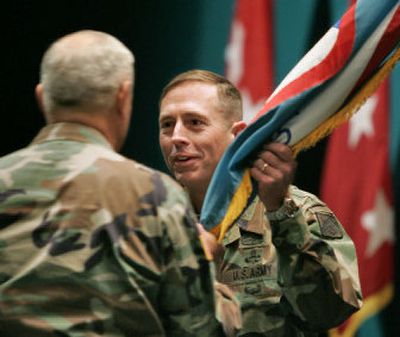Army retooling to fight insurgencies

FORT LEAVENWORTH, Kan. – At this historic Army post on a bluff overlooking the Missouri River, the Army has mounted an intense effort to train its soldiers how to fight insurgents more effectively in Iraq, Afghanistan and beyond.
Fort Leavenworth is where all-black regiments known as “buffalo soldiers” once galloped off to police the American frontier. Later generations here studied how to defeat Soviet tank divisions. Now the United States Army Combined Arms Center has retooled the Army’s leadership and training programs to focus on what motivates insurgents, the strategies and tactics they use and the cultures in which they operate.
The shift away from major combat operations to irregular warfare is one of the most significant changes in doctrine and training the Army has undertaken since World War II.
“It’s a big change for our Army,” said Lt. Gen. David Petraeus, the Iraq war veteran who commands the Combined Arms Center. “Although we have done lots of counterinsurgency operations over the years, historically we have, as an institution, tended to refocus on major combat operations, the big battles, after each of our counterinsurgency operations was over.”
The last time the U.S. Army fought a major counterinsurgency war was 40 years ago in Vietnam. The Army fought a smaller counterinsurgency war in El Salvador in the 1980s and intervened in Somalia, Haiti and the Balkans in the 1990s. But the Army’s primary focus remained winning an all-out conventional war in Europe against the Soviet Union and the Warsaw Pact.
Irregular war and stability operations were considered lesser tasks that required little preparation or practice.
Large-scale war remained the Army’s focus even after the invasion of Iraq in 2003. Since then, however, that focus has changed as it’s become clear that Iraq and Afghanistan are part of a long guerrilla struggle that could last decades.
“One of the light bulbs that’s come on in the last year or so is to no longer accept the notion that … if you can do high-end major combat operations and you’ve got a disciplined force, then you can do this other stuff,” Petraeus said. “But that’s not the case. If you want to do this other stuff, then you’ve got to train for it.
“The greater goal is to help our Army truly be a learning organization, one that is adapting in response to the challenges we face in the long war (and) one that strives to ensure basic combat competence, but also a degree of confidence in a number of the other tasks that our soldiers are asked to perform,” Petraeus said.
That means preparing soldiers for everything from high-intensity combat to peacekeeping and reconstruction. Soldiers in Iraq and Afghanistan can be asked to hunt down insurgents one day, guard polling stations another and rebuild schools the next.
Waging a successful counterinsurgency war means that military commanders must be prepared to carry out all those missions at once, while taking into account what political and economic effects their actions will have, officials say.
“Sometimes the best action is inaction,” said Clinton Ancker III, the director of the Combined Arms Center Doctrine Directorate. “It’s a very difficult job balancing the application of force.”
Lessons such as that are at the heart of the changes the Combined Arms Center is helping to make across the Army and other services.
A team from the Army and the Marine Corps is writing the military’s first counterinsurgency field manual in 20 years. A main theme is that military action is only a means to a political end.
“This manual is as much about the next fight in the GWOT (global war on terrorism),” said Ancker, who’s overseeing the project. “It’s not solely about the one we’re in now.”
At the Army’s three large training centers – Fort Irwin, Calif., Fort Polk, La. and Hohenfels, Germany – soldiers now train in mock Iraqi and Afghan villages.
The exercises involve hundreds of Arab and Afghan American role players. Soldiers are given a number of missions to accomplish while fending off improvised explosive and sniper attacks. Whether they succeed depends on the relationships they establish with the villagers.
Basic trainees at Army bases in Georgia, South Carolina, Kentucky, Missouri and Oklahoma now learn how to spot and avoid roadside bombs, react to ambushes on their convoys and train with local security forces.
Hundreds of additional students enroll annually in Arabic, Pashtun and other languages at the Defense Language Institute in Monterey, Calif. And any soldier can download a course in Arabic from the Army’s Web site for free.
Computer specialists at Fort Leavenworth’s Battle Command Knowledge System run three dozen online forums where soldiers in the field can share information.
Books on al-Qaida, militant Islam, Iraqi and Afghan history and the Muslim world are now required reading for majors and lieutenant colonels at the Army Command and General Staff College at Fort Leavenworth. There also are courses on Middle East culture and on Islam. A week is devoted to the study of irregular warfare.
“We can’t make them a cultural expert in every culture that exists over there,” said Russ Crumrine, a Middle East specialist who teaches there. “But the key is to get them thinking about what they need to know and how they might apply it.”